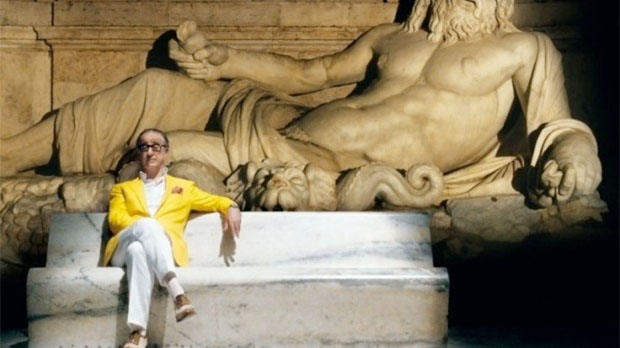Paolo Sorrentino’s The Great Beauty is high falutin art
cinema at its artiest. It’s long, 142 mins, and deliberately invokes Fellini
and Antonioni. There’s little in the
way of plot yet if I said it was episodic or that the film was based on a
series of set pieces or tableaux vivants I think that would be misleading too.
Its construction has a delicious sweep, rhythm and poetry to it, held together by camera
work that swoops, glides and circles, and by a central performance by Toni
Servillo (brilliant, as he was in The
Consequences of Love and Gomorrah).
Servillo is Jep
Gambardella, 65, an established journalist and writer but really a socialite and flâneur. He only wrote one successful novel when he was in his twenties.
He knows everyone and everyone knows him. He mixes with the rich and the
famous, the clergy and the gangsters, the artists and the actors. The first
part of the film establishes the milieu and the tone of the movie and it’s only
then that Sorrentino introduces the one main plot point. Jep’s former lover, a woman he hasn’t seen in
30 years has died and this causes him to revisit his past and consider his
life.
Through Jep’s eyes
we see the decadence of the rich in Berlosconi’s Italy; its emptiness and
sourness, and also its moral and intellectual bankruptcy. Thankfully we are
also given the glamour and the good times, the parties and the beautiful people.
It was the first time my new surround sound really earned its money as I felt a
thumping baseline reverberate around my front room and deep into my chest. You
feel the heady appeal of what it might be like to be rich and carefree,
dissolute and profligate whilst seeing the ruefulness and ennui at the heart of most of their lives. This is one of the wonders of the film – you feel
that push and pull but not in any kind of heavy-handed, didactic way. Part of that
is down to Servillo’s Jep. He is resolved to this life; comfortable and
resigned, compromised and happy, with a world-weary wisdom and a cynicism that
somehow doesn’t alienate. When that real understanding of the world is combined
with his grief and, possibly, regret, the film accrues unexpected depth and
humanity. The other key ingredient to the film’s mysterious balance of forces
is Rome itself. Sorrentino captures the city’s bewildering beauty in a way I’ve
never experienced before, combining his array of images with a beautiful score.
I’m kind of in awe
of this film I think. I watch it open-mouthed, bewitched. Unlike so many films
that seduce on a first viewing only to disappoint when watched again, The Great Beauty just keeps on hypnotizing
me. I can only compare it’s mastery of
technique to middle-period Scorsese or even Bertolucci’s The Conformist. The trouble with calling The Great Beauty high falutin is that you might think it’s too
subtle or boring or pretentious to bother with. It certainly has its baffling
moments – the introduction of a female stripper called Ramona in the middle
section of the film, who then disappears almost without comment, IS baffling on
your first viewing. Yet the film is rarely subtle – indeed a good word for it
might be operatic, and I was never, ever bored. Rather the main problem that
readers of this blog may have is with what I can only call the preponderance of
the male gaze - there certainly is a fair amount of female flesh on show in the
early part of the film. Some of the images are undoubtedly meant to have erotic
overtones but as with so much of the film, Sorrentino wants to seduce us AND
show us the seediness. This is the life of the rich, Sorrentino is saying to us,
this is how they look, this is how they desire, and it would be a lie not to
acknowledge its appeal too, however superficial.
As I
watch my favourite films of 2013 again it’s thrilling to see how vital and
relevant they are.


No comments:
Post a Comment